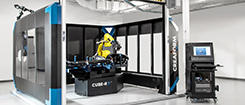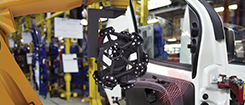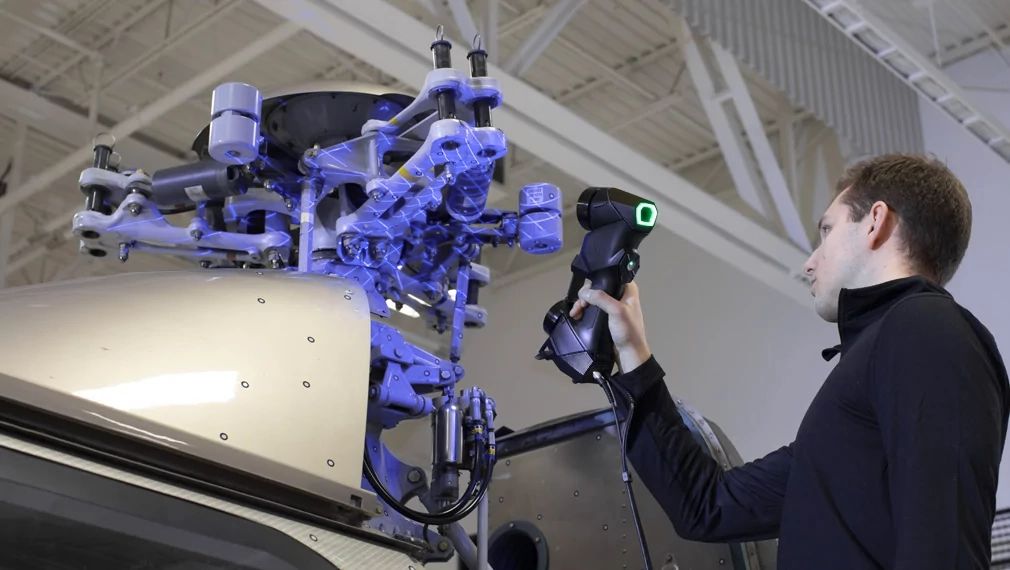July 24, 2024
Improving Vessel Integrity at a Refinery thanks to Advanced 3D Scanning Technology See the articleAutomation is the use of technology to produce and deliver parts with minimal human intervention. The integration of automated systems into the manufacturing process improves the efficiency, reliability, and repeatability of many tasks that were previously performed by humans, whose focus can now be redirected to less repetitive and more judgment-intensive activities.
By limiting scrap rates, production waste, and rework, automation contributes to continuous improvement and productivity gains. This blog post aims to guide manufacturers who are interested in automated solutions but remain hesitant about implementing these new technologies. More precisely, it attempts to answer the following questions:
- How does automation contribute to solving problems before they become critical for the company’s bottom line?
- How can productivity gains be translated concretely into the company’s operational and financial management?
- How can manufacturers familiarize themselves with new technologies, leverage the potential of automation, and capitalize on these productivity gains in their day-to-day activities?
- 1 Upstream Control rather than Downstream Correction
- 2 Concrete Impact of Productivity Gains
- 3 Survey Confirms Reasons to Implement Automated Control Quality (AQC)
- 4 Survey Reveals Factors Preventing the Deployment of an AQC System
- 5 ROI Calculation
- 6 Expertise in Robotics
- 7 3 Steps to Become Comfortable with New Technologies
- 8 AQC for a Better Bottom Line
Upstream Control rather than Downstream Correction
Generally, companies look for solutions to solve current and urgent problems that they are experiencing in the present moment and that have immediate consequences. Thus, the corrective actions to solve these critical problems tend to be more reactive and taken mostly downstream of the production line.
A more effective approach is to investigate the sequence of operations that led to non-conformity. By tracing the manufacturing process, they can identify upstream actions that will significantly reduce the downstream efforts needed to solve recurring problems. Thus, proactive corrective solutions can be deployed to eliminate quality problems once and for all.
To do so, automated control is key. Automation contributes to finding anomalies as soon as they occur upstream and before they become major defects downstream. This prevents errors from being multiplied and allows corrective actions to be taken before defective parts are produced and shipped to customers.
Concrete Impact of Productivity Gains
The productivity gains obtained through automation can be devoted to improving product quality, responding to the lack of skilled workers, and accelerating the development and time-to-market for new products.
Concretely, improving product quality means reducing—or better, eliminating—rework, scrap, and waste, which are generally synonymous with heavy financial losses for manufacturers. New technologies, such as 3D scanners, robots, and automated systems, are engineered to continuously control product quality. When these solutions are deployed, quality improves and the efficiency, reliability, and repeatability of manufacturing processes are enhanced, which contributes to reducing production costs.
Because automated quality control systems ensure product quality, skilled workers can be put to better use; for instance, their time can be dedicated to analyzing data, identifying the problems causing non-conformity, and proposing corrective solutions. This way, they contribute to improving the profitability of the company, which is more rewarding than simply reworking each and every defaulted part.
Survey Confirms Reasons to Implement Automated Control Quality (AQC)
When asked why they have opted to implement an AQC system into their manufacturing process, 43% of respondents said they wanted to discover problems earlier and, thus, eliminate waste and rework, while 39% said they wanted to eliminate human error and, thus, improve repeatability.
Survey Reveals Factors Preventing the Deployment of an AQC System
When asked what primarily prevented them from deploying an AQC system, 39% of respondents said it was a lack of employees with skills in robotics, while 36% said it was the expensive price and the lack of information about the return on investment (ROI).
ROI Calculation
To compensate for this lack of information about the ROI, we questioned experts and found valid data on the costs of poor quality (COPQ), which are costs that would disappear if systems, processes, and products were perfect or if rejection rates were zero.
On average, rejection rates go from 0.6% of the business revenues for top-performing manufacturers to 2.2% for less-efficient manufacturers. Other sources also reveal that COPQ can account for as much as 5-30% of gross sales for manufacturing and service companies. Therefore, cutting only 1% of waste, scrap, or rework on a $50,000,000 business turnover can lead to $500,000 savings per year.
Improving product quality means reducing rejection rates, which are responsible for some of manufacturing companies’ most important financial losses. Moreover, at this pace, the investment required for an AQC solution could be paid off in a year or so.
Expertise in Robotics
To find out more about how the lack of employees with skills and expertise in robotics prevents project development, we asked manufacturers which phase—design, integration, or operations—they were least comfortable with. Their answers, however, did not highlight a specific phase.
Based on this information, we built an easy 3-step workflow to help manufacturing companies become more comfortable with new technologies, such as 3D scanners, robots, and automated systems, in order to eventually initiate a robotics project and, thus, leverage the potential of automation.
3 Steps to Become Comfortable with New Technologies
Step 1:
Look for tasks in your manufacturing process that need improvement and evaluate if automation is the right solution. Calculate your ROI based on the example above. Note that automation is a great tool for continuous improvement, but sometimes only moving from a manual tool (like a height gage or a micrometer) to a handheld 3D scanner can offer productivity gains too.
Step 2:
Once a company finds a task for which automation makes sense financially, the second step is to choose the right technology to measure the parts. 3D scanning technologies provide fast metrology-grade results. Since important decisions will be made from the data gathered by the AQC solution, it is critical to choose the right technology. The MetraSCAN-R BLACK|Elite is designed to deliver highly accurate and repeatable results for parts, even on complex shapes or various material finishes, including highly shiny materials.
Step 3:
Finally, struggles with the design or the integration phases should not stop a manufacturing company from moving forward with its robotics project. System integrators have the expertise to help you deploy your robotics system. However, even if a system integrator supports the design and integration phases, the company will still need to assume some project management tasks, in addition to paying for the engineering of the solution.
Another option, however, is to opt for a turnkey solution like the CUBE-R, which leverages the power of the MetraSCAN 3D-R. The CUBE-R is a high-productivity industrial measuring cell that is designed to be integrated into factories for at-line inspections without the need for a system integrator.
AQC for a Better Bottom Line
As manufacturing companies around the globe implement automation into their quality control processes, they see the benefits of finding defects earlier in the manufacturing process and limiting human error. As they list fewer scrap parts, record less waste, and resort to minimal rework, their bottom line improves.
In short, automation enhances the efficiency, reliability, and repeatability of manufacturing processes, enabling companies to reduce their production costs, deliver more and better products to their customers, and get a return on their investment quickly and efficiently.


![A recent survey showed that automated quality control is implemented into the manufacturing process to: [7%] Mitigate non-added-value tasks and ensure better use of staff potential [43%] Improve workflow and find defects earlier [39%] Ensure that all parts are measured correctly every time without human error and subjectivity [11%] Increase the number of measurements](https://www.creaform3d.com/blog/pun5th75ef_wp/wp-content/uploads/Why-Automation-Graph-1-1280x720-1-1024x576.png)
![A recent survey showed that the main factors preventing the deployment of AQC systems are: [11%] Accuracy: no solution is accurate enough [39%] Experience: lack of employees with skills in robotics [36%] Price: too expensive, and ROI is not there [14%] Speed: no solution is fast enough](https://www.creaform3d.com/blog/pun5th75ef_wp/wp-content/uploads/Why-Automation-Graph-2-1280x720-1-1024x576.png)
![A recent survey showed that the project phase with which are manufacturers are least comfortable are equally divided among the following: [33%] Design [33%] Integration [33%] Operations](https://www.creaform3d.com/blog/pun5th75ef_wp/wp-content/uploads/Why-Automation-Graph-3-1280x720-1-1024x576.png)









